
Page 14
WHAT TO DO IF CARBON MONOXIDE IS DETECTED
Never ignore the alarm sound.
If you hear the alarm horn
sounding a continuous horn pattern of 4 beeps, 5 second pause, carbon monoxide has been
detected. Evacuate everyone from the dwelling.
Never disconnect the power from the alarm to stop a nuisance alarm.
Doing
so will disable the alarm and remove the protection. In the case of a true unwanted alarm,
use the silence feature. The silence feature is intended to temporarily silence the alarm while
the problem is identified and corrected. Open a window or fan the CO away from the alarm.
The alarm will reset automatically when it returns to normal operation. . The alarm will stop
sounding automatically
Actuation of your CO Alarm indicates the presence of
carbon monoxide (CO), which can kill you.
In other words, when your CO Alarm
sounds, you must not ignore it! Some individuals are more sensitive to CO than others, in-
cluding people with cardiac or respiratory problems, infants, unborn babies, pregnant mothers
and elderly people can be more quickly and severely affected by CO. Members of sensitive
populations should consult their doctors for advice on taking additional precautions.
IF THE CO ALARM SOUNDS:
1. Operate the Silence button.
2. Call your emergency services, fire department or 911. Write down the number of your local
emergency service here: ___________________________________.
3. Immediately move to fresh air—outdoors or by an open door or window. Do a head count to
check that all persons are accounted for. Do not reenter the premises or move away from
the open door or window until the emergency services responder has arrived, the premises
have been aired out, and your alarm remains in its normal condition.
4. After following steps 1-3, if the alarm reactivates within a 24 hour period, repeat steps 1-3
and call a qualified appliance technician to investigate for sources of CO from fuel-burning
equipment and appliances and inspect for proper operation of this equipment. If problems are
identified during this inspection, have the appliances and equipment serviced immediately.
Note any combustion equipment not inspected by the technician and consult the manufactur-
ers’ instructions or contact the manufacturer(s) directly for more information about CO safety
and this equipment. Make sure that motor vehicles are not, and have not been, operating in
an attached garage or adjacent to the residence. Write down the number of a qualified appli-
ance technician here: _______________________________________________________.
NOTE:
A qualified appliance technician is defined as “a company engaged in and responsi-
ble for the installation, testing, servicing, or replacement of heating, ventilation, air condi-
tioning (HVAC) equipment, combustion appliances and equipment, gas fireplaces or other
combustion equipment.”
Because carbon monoxide may dissipate by the time a first responder or investigator arrives, it may be difficult to
locate the source of CO. USI Electric/Universal Security Instruments shall not be obligated to pay for or reimburse the
user of this alarm for any carbon monoxide investigation or service calls. Fire departments, HVAC contractors and most
utility companies will perform CO inspections. Some may charge for this service. It is advisable to inquire about any
applicable fees prior to having the service performed
POTENTIAL SOURCES OF CARBON MONOXIDE
Carbon monoxide (CO) is a colorless, invisible, odorless, tasteless, poisonous gas produced
when fossil fuels do not burn completely, or are exposed to heat, usually fire. This alarm is not
designed to detect any other gas. This alarm will only indicate the presence of CO or smoke
which reaches the sensor. Carbon monoxide and natural gas may be present in other areas.
Fossil fuels
such as wood, charcoal, coal, natural gas, oil, gasoline, propane and kerosene produce CO.
Household appliances
may be sources of CO and include the gas kitchen range, cook top,
gas clothes dryer, heater, furnace, water heater, wood-burning stove, certain pool heaters,
fireplaces and portable space heathers. When they are not properly maintained, are improp-
erly ventilated, or malfunction, CO levels can rise quickly.
Electrical appliances
typically do not produce CO.
Energy efficient homes.
CO is a real danger now that homes are more “air-tight”, with
added insulation, sealed windows, and other weatherproofing can trap CO inside.
Damaged or insufficient venting
such as; corroded or disconnected water heaters, vent
pipes, leaking chimneys, pipes or flues or cracked heat exchangers, blocked or clogged
chimney openings.




































